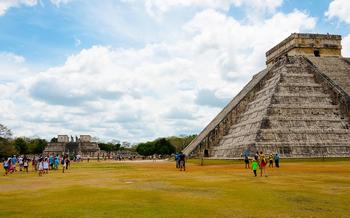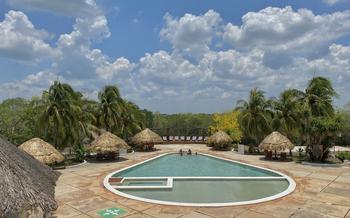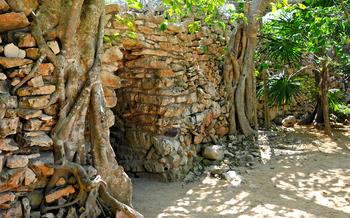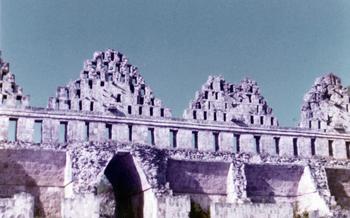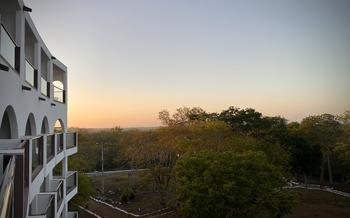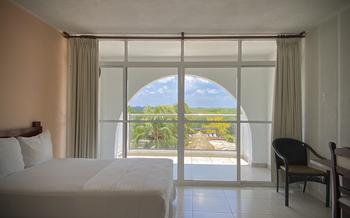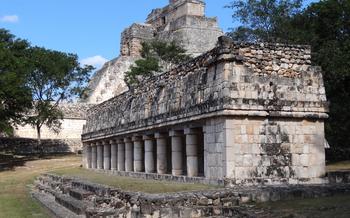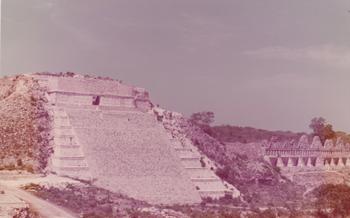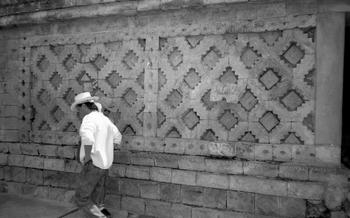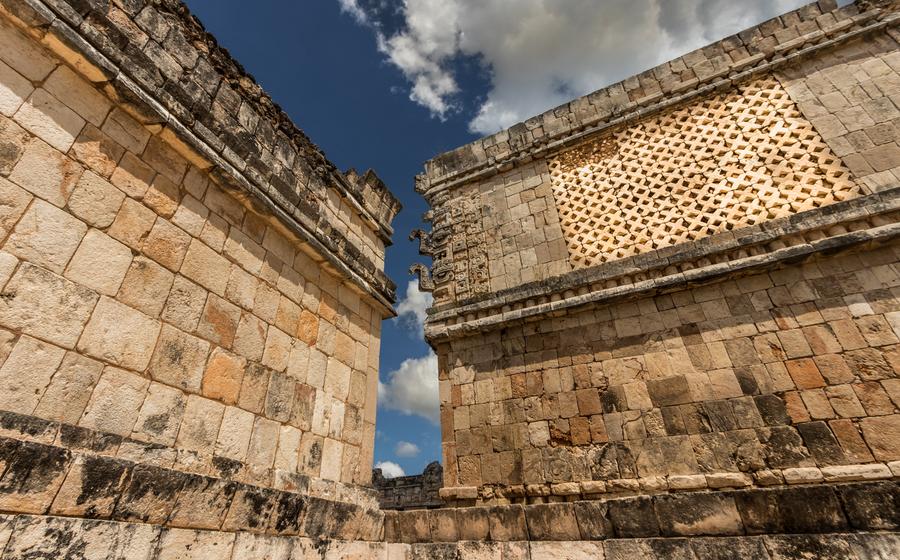
Mayapan Archaeological Site
- The Great Pyramid of Uxmal: A Symbol of Mayan Architectural Prowess
- The Nunnery Quadrangle: A Complex of Intricate Buildings
- The House of the Magician: A Testament to Mayan Astronomical Knowledge
- The Ball Court: A Place of Ritual and Competition
- The Temple of the Old Woman: A Mysterious and Enigmatic Structure
- The Governor's Palace: A Glimpse into Mayan Elite Life
- The East Group: A Complex of Residential and Ceremonial Buildings
- The Cenote Xlacah: A Sacred Water Source
- The Light and Sound Show: A Multimedia Spectacle
- Practical Information
- Insider Tip: Enhance Your Experience
- Uxmal Museum: A Treasure Trove of Mayan Artifacts
- Mayapan Archaeological Site: A Thriving Post-Classic Mayan City
- Combined Uxmal and Mayapan Tour: A Full-Day Mayan Adventure
- Insider Tip: Unforgettable Sunrise and Sunset Views
The Great Pyramid of Uxmal: A Symbol of Mayan Architectural Prowess
The Great Pyramid of Uxmal, also known as the Pyramid of the Magician, is the most iconic structure in the archaeological site. Standing at an impressive 35 meters (115 feet) tall, it is the tallest building in Uxmal and one of the tallest Mayan pyramids in the Yucatan Peninsula. The pyramid's construction is a testament to the architectural prowess of the Mayans and their ability to create massive structures without the use of metal tools or wheels.
The Great Pyramid is believed to have been built in the 10th century AD as a temple dedicated to the Mayan rain god Chaac. The pyramid's design is unique in that it has an elliptical base, which gives it a distinctive shape when viewed from afar. The pyramid also features a series of intricate carvings and sculptures, including representations of Chaac and other Mayan deities.
Climbing the pyramid is permitted, but it requires a certain level of fitness and caution. The climb involves ascending a steep and narrow staircase, and visitors should be prepared for the heat and humidity. The climb is worth the effort, however, as it offers stunning views of the surrounding jungle and the other structures in Uxmal.
The Nunnery Quadrangle: A Complex of Intricate Buildings
Amidst the ruins of Uxmal, the Nunnery Quadrangle stands out as a remarkable architectural complex, showcasing the intricate artistry and craftsmanship of the ancient Mayans. While its name may suggest a religious purpose, this quadrangle served various functions, including residential, administrative, and ceremonial.
The complex consists of four elongated buildings arranged around a central courtyard, each adorned with intricate carvings and sculptures. The exterior facades feature elaborate geometric patterns, human figures, and mythical creatures, reflecting the Mayans' deep reverence for nature and their spiritual beliefs.
Inside the buildings, visitors can admire well-preserved rooms, each with its own unique features. Some rooms display intricate wall paintings depicting scenes from Mayan mythology and daily life, providing valuable insights into their culture and customs. Others contain altars, thrones, and other ceremonial objects, suggesting the quadrangle's importance in religious ceremonies and rituals.
One of the most striking features of the Nunnery Quadrangle is the abundance of sculptures and carvings. Human figures, animals, and mythical beings adorn doorways, lintels, and pillars, creating a sense of awe and wonder. These intricate carvings offer glimpses into the Mayan worldview and their deep connection to the natural world.
The Nunnery Quadrangle is a testament to the Mayans' architectural prowess and their ability to combine functionality with aesthetic beauty. It is a must-see attraction for anyone interested in exploring the rich history and culture of this ancient civilization.
The House of the Magician: A Testament to Mayan Astronomical Knowledge
The House of the Magician, also known as the Pyramid of the Magician, is another architectural masterpiece within the Uxmal archaeological site. Its unique design and astronomical significance make it a must-see for visitors. The pyramid has a rounded base and an elliptical shape, unlike the typical square or rectangular pyramids found elsewhere in the Maya region.
Its design is believed to align with celestial events, particularly the winter solstice. During the winter solstice, the setting sun aligns perfectly with the northwest corner of the pyramid, creating a mesmerizing shadow effect. This alignment suggests that the Mayans had advanced knowledge of astronomy and used the pyramid as an astronomical observatory.
The pyramid's name originates from a local legend that claims a powerful sorcerer built it in a single night using magic. While the legend may be mythical, it reflects the Mayans' awe and admiration for the pyramid's architectural prowess and its connection to the heavens.
The House of the Magician is not open for climbing, but visitors can admire its grandeur from the ground level. Its unique shape and astronomical significance make it a fascinating example of the Mayans' architectural and scientific achievements.
The Ball Court: A Place of Ritual and Competition
The ball court at Uxmal is an impressive sight, measuring 380 feet long and 115 feet wide. Its sloping sides and vertical end zones create a dramatic arena for the ancient Mesoamerican ballgame. This ritualistic sport held deep significance for the Mayans, combining elements of religion, competition, and social interaction.
The ballgame was not merely a game; it was a sacred ritual with profound symbolism. The Mayans believed that the outcome of the game could influence the agricultural cycle, ensure fertility, and bring good fortune to the community. The players, often adorned in elaborate costumes, represented different deities and competed fiercely to score points by hitting a heavy rubber ball through a stone hoop mounted high on the court walls.
Beyond its religious significance, the ballgame also had social and cultural implications. It served as a form of entertainment, a way to settle disputes, and a means of showcasing strength and agility. The Mayans believed that the game's outcome could determine the fate of individuals, families, and even entire communities, making it a highly charged and emotionally intense event.
The Temple of the Old Woman: A Mysterious and Enigmatic Structure
Amidst the grandeur of Uxmal, the Temple of the Old Woman stands as a captivating enigma, its history shrouded in mystery and folklore. This imposing structure, perched atop a towering platform, is a testament to the intricate architectural prowess of the ancient Mayans. Its well-preserved facade showcases intricate carvings and bas-reliefs that hint at the rich symbolism and religious beliefs of this ancient civilization.
Legends and tales woven around this enigmatic temple have captured the imagination of visitors for centuries. One popular legend speaks of an elderly Mayan woman who possessed supernatural powers and was revered as a wise oracle. It is said that she made prophecies and predictions that guided the people of Uxmal through times of uncertainty and prosperity.
Archaeological excavations and ongoing research continue to shed light on the historical significance of this enigmatic structure. Discoveries of artifacts, inscriptions, and ritualistic objects have provided valuable insights into the religious practices and beliefs of the ancient Mayans. The temple's alignment with celestial events and its intricate carvings suggest that it served as an important ceremonial center for astronomical observations and rituals.
As you explore the Temple of the Old Woman, let your imagination wander and embrace the mystery that surrounds it. Imagine the ancient Mayans gathering within its sacred chambers, seeking guidance and wisdom from the revered oracle. Marvel at the intricate carvings that adorn its walls, each symbol and motif holding a hidden meaning and story. The Temple of the Old Woman stands as a testament to the enduring legacy of the Mayans, inviting visitors to unravel its secrets and connect with the rich history and culture of this ancient civilization.
The Governor's Palace: A Glimpse into Mayan Elite Life
The Governor's Palace in Uxmal stands as a testament to the grandeur and opulence of Mayan elite life. This imposing structure, situated at the heart of the ancient city, served as the seat of power for the city's rulers. Its architectural splendor, adorned with intricate carvings and towering walls, reflects the power and prestige of the Mayan governors who once resided within its walls.
The palace complex comprises an array of interconnected rooms, courtyards, and living quarters, each serving a specific purpose in the daily lives of the Mayan elite. Elaborate thrones, adorned with intricate carvings depicting Mayan deities and symbols of power, dominate the grand halls, symbolizing the authority of the rulers. The palace also features a series of courtyards, some adorned with lush gardens and water features, providing a tranquil retreat from the bustling city.
The Governor's Palace offers a glimpse into the opulent lifestyle of the Mayan elite. Evidence of their wealth and status can be seen in the luxurious furnishings, imported goods, and exotic artifacts that once adorned the palace's chambers. The palace also served as a venue for important ceremonies and rituals, further emphasizing the central role of the governor in Mayan society.
The East Group: A Complex of Residential and Ceremonial Buildings
The East Group is a large complex located to the east of the Great Pyramid. It consists of a diverse array of residential and ceremonial buildings, offering a glimpse into the daily life and religious practices of the ancient Mayans. Visitors can explore a range of structures, including palaces, temples, and altars, each with its own unique architectural features and significance.
The East Group is believed to have served as a residential area for the elite members of Mayan society. The palaces feature elaborate decorations, spacious rooms, and courtyards, indicating the high status of their occupants. The temples, on the other hand, were used for religious ceremonies and rituals. These structures are often adorned with intricate carvings and sculptures depicting Mayan deities and mythological scenes.
Notable features of the East Group include the Altar of the Bacabs, a massive stone altar dedicated to the four Mayan gods of the winds, and the Stela 10, a carved stone monument with inscriptions providing valuable historical information about the site. Visitors can also explore the courtyards, which were used for gatherings, ceremonies, and other social activities.
Wandering through the East Group, visitors can immerse themselves in the daily life of the ancient Mayans. The complex offers a fascinating glimpse into the social hierarchy, religious beliefs, and cultural practices of this remarkable civilization.
The Cenote Xlacah: A Sacred Water Source
Amidst the ruins of Uxmal, the Cenote Xlacah stands as a testament to the Mayans' deep connection with nature and their reverence for water. This natural well, with its crystal-clear waters and limestone walls, was considered a sacred site, believed to be a portal to the underworld. The Mayans performed rituals and ceremonies here, seeking divine guidance and protection.
Archaeological excavations have revealed a wealth of offerings at the cenote, including pottery, jewelry, and even human remains. These offerings suggest that the cenote was not only a source of water but also a place of spiritual significance, where the Mayans sought to appease the gods and maintain harmony with the natural world.
In Mayan culture, cenotes were believed to be conduits to the underworld, Xibalba, and were associated with fertility, rain, and abundance. The Mayans regarded water as a precious resource and revered cenotes as sacred places, often building temples and shrines nearby.
Visiting the Cenote Xlacah is a unique opportunity to immerse yourself in the spiritual and cultural traditions of the ancient Mayans. Take a moment to reflect on their deep respect for nature and the sacredness of water, marveling at the beauty and tranquility of this natural wonder.
The Light and Sound Show: A Multimedia Spectacle
Uxmal comes alive after dark with its captivating light and sound show, a multimedia extravaganza that narrates the history and culture of the ancient Mayans. As darkness envelops the ruins, colorful lights illuminate the majestic structures, casting intricate shadows that dance across the ancient stones. The show's soundtrack, a harmonious blend of traditional Mayan melodies and modern compositions, transports visitors back in time, creating an immersive and enchanting experience.
The show unfolds in several acts, each highlighting a different aspect of Mayan civilization. The story begins with the city's foundation and its rise to prominence as a powerful Mayan kingdom. It then delves into the daily lives of the Mayans, showcasing their customs, traditions, and beliefs. The show also touches upon the city's eventual decline and abandonment, leaving visitors with a sense of wonder and contemplation.
Beyond its historical and cultural significance, the light and sound show is a testament to the enduring legacy of the Mayans. It is a celebration of their ingenuity, artistry, and deep connection to their natural surroundings. The show serves as a reminder of the importance of preserving and protecting this rich cultural heritage for future generations.
Practical Information
- Timing: The light and sound show is typically held twice a night, starting at 7:00 PM and 8:30 PM.
- Cost: Tickets for the show cost around $10-$15 USD.
- Booking: Advance booking is recommended, especially during peak tourist season. Tickets can be purchased online or at the Uxmal Visitor Center.
Insider Tip: Enhance Your Experience
To fully appreciate the magic of the light and sound show, arrive early and secure a good spot. The show is best viewed from a central location, allowing you to soak in the panoramic views of the illuminated ruins. Don't forget to bring a camera to capture the stunning visuals and create lasting memories of your Uxmal adventure.
Uxmal Museum: A Treasure Trove of Mayan Artifacts
Housed within the archaeological site of Uxmal, the Uxmal Museum serves as a repository of priceless artifacts that illuminate the rich history and culture of the ancient Mayans. This treasure trove of cultural heritage offers a captivating journey through the lives and achievements of this enigmatic civilization.
In the museum's well-curated exhibits, visitors can marvel at intricate stone sculptures, finely crafted pottery, and elaborate jewelry that showcase the Mayans' remarkable artistic prowess. Among the most notable artifacts are the exquisitely carved stelae, which tell stories of rulers, battles, and religious ceremonies, providing valuable insights into Mayan history and mythology.
The museum also houses a collection of everyday objects, such as tools, weapons, and household items, that shed light on the daily lives of the ancient Mayans. These artifacts offer a glimpse into the practical aspects of Mayan society, from their agricultural practices to their culinary traditions.
The Uxmal Museum stands as a testament to the enduring legacy of the Mayans. It is a place where visitors can delve into the depths of this ancient civilization, appreciate their remarkable achievements, and gain a deeper understanding of their unique culture and way of life.
Mayapan Archaeological Site: A Thriving Post-Classic Mayan City
Mayapan is another significant Mayan city located about 40 kilometers southwest of Uxmal. It was founded around 1200 AD and quickly rose to become one of the most powerful and influential cities in the Yucatán Peninsula during the Post-Classic period. Mayapan was the capital of the League of Mayapan, a political alliance that controlled much of the region for over 200 years.
The city is smaller than Uxmal but still boasts impressive architecture and a rich history. Among its notable features are several pyramids, including the Pyramid of Kukulcan, which is similar in size and design to the pyramid at Chichén Itzá. Mayapan also has several temples, a ball court, and a large central plaza.
One of the most distinctive features of Mayapan is its fortifications. The city was surrounded by a massive wall, which is still partially intact today. This wall was likely built to protect the city from attack, as Mayapan was frequently engaged in warfare with its neighbors.
Mayapan's decline began in the late 14th century, and by the 15th century, it was abandoned. The reasons for its decline are not fully understood, but it is thought that a combination of factors, including warfare, drought, and disease, may have contributed to its collapse.
The ruins of Mayapan are now a popular tourist destination, and visitors can explore the city's many temples, pyramids, and other structures. Mayapan is a fascinating glimpse into the Post-Classic period of Mayan history, and it is a worthwhile destination for anyone interested in learning more about this ancient civilization.
Combined Uxmal and Mayapan Tour: A Full-Day Mayan Adventure
If you're seeking a comprehensive Mayan experience, consider embarking on a combined tour of Uxmal and Mayapan. This full-day adventure allows you to delve deeper into the history and culture of this ancient civilization. The tour typically begins with a visit to Uxmal, where you'll explore its iconic structures, including the Great Pyramid, the Nunnery Quadrangle, and the House of the Magician. After a delicious lunch break, the journey continues to Mayapan, where you'll discover the remnants of a once-thriving post-Classic Mayan city. Explore its impressive pyramids, temples, and ball courts, and learn about the unique characteristics that set Mayapan apart from other Mayan settlements. Throughout the tour, knowledgeable guides will share fascinating insights into Mayan history, architecture, and daily life, making this a truly immersive and educational experience.
Practical Information:
-
Cost: Combined Uxmal and Mayapan tours typically range from $70 to $120 per person.
-
Booking: Advance booking is recommended to secure your spot, especially during peak tourist season.
-
Transportation: Most tours include round-trip transportation from major cities in the Yucatan Peninsula, such as Cancun, Playa del Carmen, and Merida.
-
Duration: The tour usually lasts for approximately 10-12 hours, allowing ample time to explore both Uxmal and Mayapan in depth.
Advantages of Guided Tours:
- Convenience: Guided tours eliminate the hassle of planning your own itinerary and transportation.
- Expertise: Knowledgeable guides provide valuable insights and historical context, enhancing your understanding of the Mayan civilization.
- Efficiency: Guided tours ensure you make the most of your time by visiting the most important sites and avoiding crowds.
- Safety: Traveling with a group and an experienced guide can provide peace of mind, especially if you're unfamiliar with the area.
Insider Tip: Unforgettable Sunrise and Sunset Views
While exploring the wonders of Uxmal and Mayapan, don't miss the opportunity to witness the magical play of light during sunrise and sunset. The ancient structures take on a mystical aura as the golden hues of the rising or setting sun illuminate the intricate carvings and architectural details.
For the most breathtaking sunrise views, head to the Great Pyramid. As the first rays of sunlight peek over the horizon, the pyramid's silhouette against the fiery sky creates a truly awe-inspiring sight. For sunset vistas, the Temple of the Magician offers an unparalleled panorama. Watch as the warm glow of twilight bathes the building, casting long shadows across the surrounding landscape.
To capture the essence of Uxmal's sunrise and sunset, bring your camera and tripod. Experiment with different angles and compositions to create stunning photographs that will forever remind you of your Mayan adventure. Remember to arrive early to secure a good spot and enjoy the tranquility of the surroundings before the crowds arrive.
